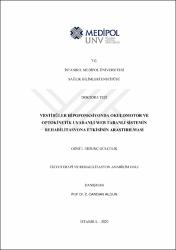Vestibüler hipofonksiyonda okulomotor ve optokinetik uyaranlı web tabanlı sistemin rehabilitasyona etkisinin araştırılması
Künye
Ertunç Gülçelik, G. (2020). Vestibüler hipofonksiyonda okulomotor ve optokinetik uyaranlı web tabanlı sistemin rehabilitasyona etkisinin araştırılması. (Yayınlanmamış doktora tezi). İstanbul Medipol Üniversitesi Sağlık Bilimleri Enstitüsü, İstanbul.Özet
Vestibüler rehabilitasyonda kullanılan teknolojilerin çeşitliliği ve kullanımı oldukça az görülmektedir. Çalışmamızın amacı; unilateral vestibüler hipofonksiyonu olan hastalarda, okulomotor ve optokinetik uyaranlı web tabanlı sistemin vestibüler rehabilitasyona etkisini araştırmaktır. 18-70 yaş arası, unilateral vestibüler hipofonksiyonu olan, görme engeli olmayan, nörolojik hastalığı bulunmayan, iletişim problemi olmayan gönüllü 20 hasta basit randomizasyon yöntemi ile iki gruba ayrıldı. 8 haftalık tedavi protokolünde; kontrol grubuna konvansiyonel vestibüler rehabilitasyon, çalışma grubuna ise okulomotor ve optokinetik uyaranlı VOR'u destekleyen vestibüler sistem (SVORE) ile birlikte vestibüler rehabilitasyon programı uygulandı. Rehabilitasyon etkinliğini araştırmak için tedavi öncesi ve sonrası; vestibüler ve denge testleri, okulomotor fonksiyon seviye belirlenmesi, 10 m yürüme testi, Tampa Kinezyofobi Ölçeği ve Dizziness Handicap Envanteri uygulandı. Grup içi ve gruplararası sonuçlar arasında istatistiksel analizler yapıldı. Kontrol ve çalışma gruplarında; grup içi analizler sonucunda vestibüler semptom ve bulgularda, denge testlerinde, okulomotor fonksiyonlarda, yürüme hızında, Tampa Kinezyofobi Ölçeğinde ve Dizziness Handicap Envanterinde tedavi öncesi değerlere kıyasla anlamlı iyileşme görülmüştür (p<0,05). Gruplararası analizler sonucunda; çalışma grubundaki iyileşme gözler kapalı romberg, semitandem ve sol tek ayak duruş pozisyonu denge testlerinde istatistiksel olarak daha anlamlı bulunmuştur (p<0,05). Gruplardaki diğer değerlendirme sonuçları arasında ise anlamlı fark bulunmamıştır (p≥0,05). Vestibüler rehabilitasyonda okulomotor ve optokinetik uyaranlı web tabanlı sistemin etkili olduğunu görülmüştür. The variety and use of technologies used in vestibular rehabilitation is very limited. The purpose of this study is to investigate the effects of a web-based system with oculomotor and optokinetic stimuli on vestibular rehabilitation in patients with unilateral vestibular hypofunction. 20 volunteer patients aged 18-70 years, with unilateral vestibular hypofunction, no visual impairment, no neurological disease, no communication problems were assigned to two groups by simple randomization. In the 8-week treatment protocol, a vestibular rehabilitation program was applied to the control group with a conventional structured vestibular rehabilitation, whereas the study group received treatment with the web-based system supporting the vestibulo-ocular reflex with oculomotor and optokinetic stimulus (SVORE). Pre- and post-treatment vestibular and balance tests, oculomotor function level determination, 10 meter walk test, Tampa Kinesiophobia Scale and Dizziness Handicap Inventory were applied to evaluate the treatment's effectiveness. Statistical analyzes were performed between intra and intergroup results. In the control and study groups, intra-group analysis showed significant improvement in vestibular symptoms and findings, balance tests, walking speed, oculomotor functions, Tampa Kinesiophobia Scale and Dizziness Handicap Inventory compared to pretreatment values (p<0.05). As observed in intergroup analysis, improvement in the study group was statistically more significant with eyes closed Romberg, semi-tandem and left one-foot position balance tests (p<0.05). There was no significant difference between the other analysis results in the groups (p≥0.05). It has been observed that the web-based system with oculomotor and optokinetic stimuli is an effective means in vestibular rehabilitation.
Koleksiyonlar
- Tez Koleksiyonu [1159]


















